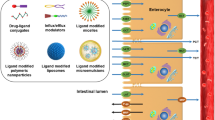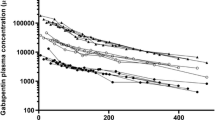Abstract
Drugs are exsorbed from the blood across the gastrointestinal membranes by passive or active processes. In the case of a passive transport mechanism, the exsorption of drugs depends on the concentration gradients between the serosal and mucosal sides. The extent of secretion (exsorption) is determined by numerous factors such as extent of binding to serum proteins, distribution volume, lipophilicity, pKa and molecular size of drugs, and the blood flow rate in the gut. Specific transport systems such as P-glycoprotein (P-gp), organic cation and organic anion transporters are found to be involved in active intestinal secretion of drugs. Intestinal secretory transport systems reduce the extent of drug absorption sometimes resulting in low oral bioavailability. It is, therefore, important to know whether poor drug absorption is due to the involvement of specialized secretory transport systems. Modulation of intestinal secretory transport can be a means to enhance absorption of drugs with low oral bioavailability if exsorption of drugs is based on active secretion pathways that are open for control from the "outside.”
Similar content being viewed by others
REFERENCES
H. Lennernäs and C. G. Regardh. Dose-dependent intestinal absorption and significant intestinal excretion (exsorption) of the beta-blocker pafenolol in the rat. Pharm. Res. 10:727–731 (1993).
A. B. Suttle and K. L. Brouwer. Gastrointestinal transit and distribution of ranitidine in the rat. Pharm. Res. 12:1316–1322 (1995).
B. L. Leu and J. D. Huang. Inhibition of intestinal P-glycoprotein and effects on etoposide absorption. Cancer Chemother. Pharmacol. 35:432–436 (1995).
H. Saitoh, C. Gerard, and B. J. Aungst. The secretory intestinal transport of some beta-lactam antibiotics and anionic compounds: a mechanism contributing to poor oral absorption. J. Pharmacol. Exp. Ther. 278:205–211 (1996).
S. F. Su and J. D. Huang. Inhibition of the intestinal digoxin absorption and exsorption by quinidine. Drug Metab. Dispos. 24:142–147 (1996).
T. Koudriakova, E. Iatsimirskaia, S. Tulebaev, D. Spetie, I. Utkin, T. Mullet, D. Thompson, P. Vouros, and N. Gerber. In vivo disposition and metabolism by liver and enterocyte microsomes of the antitubercular drug rifabutin in rats. J. Pharmacol. Exp. Ther. 279:1300–1309 (1996).
F. Sörgel and M. Kinzig. Pharmacokinetics of gyrase inhibitors, part 1: Basic chemistry and gastrointestinal disposition. Am. J. Med. 94(Suppl 3A):44S–55S (1993).
T. Gramatte, R. Oertel, B. Terhaag, and W. Kirch. Direct demonstration of small intestinal secretion and site-dependent absorption of the β-blocker talinolol in humans. Clin. Pharmacol. Ther. 59:541–549 (1996).
S. Hsing, Z. Gatmaitan, and I. M. Arias. The function of Gp170, the multidrug-resistance gene product, in the brush border of rat intestinal mucosa. Gastroenterology 102:879–885 (1992).
H. Saitoh and B. J. Aungst. Possible involvement of multiple p-glycoprotein-mediated efflux systems in the transport of verapamil and other organic cations across rat intestine. Pharm. Res., 12:1304–1310 (1995).
J. Hunter, B. H. Hirst, and N. L. Sommons. Drug absorption limited by p-glycoprotein-mediated secretary drug transport in human intestinal epithelial Caco-2 cell layers. Pharm. Res. 10:743–749 (1993).
K. Arimori and M. Nakano. The intestinal dialysis of intravenously administered phenytoin by oral activated charcoal in rats. J. Pharmacobio-dyn. 10:157–165 (1987).
Y. Imamura, K. Arimori, M. Sonoda, and H. Ichibagase. Effect of simultaneous administration of drugs on absorption and excretion. XIII. Effect of salicylic acid on the absorption, distribution and elimination of carbutamide in rabbits. Chem. Pharm. Bull. 30:2169–2176 (1982).
C. A. Loehry, A. T. R. Axon, P. J. Hilton, R. C. Hider, and B. Creamer. Permeability of the small intestine to substances of different molecular weight. Gut 11:466–470 (1970).
M. Tomita, M. Shiga, M. Hayashi, and S. Awazu. Enhancement of colonic drug absorption by the paracellular permeation route, Pharm. Res. 5:341–346 (1988).
S. Kitazawa, I. Johno, and H. Ito. Studies on characteristics of drug exsorption across the membrane of rat small intestine. Chem. Pharm. Bull. 25:2812–2820 (1977).
H. Ochsenfahrt and D. Winne. The contribution of solvent drag to the intestinal absorption of the basic drugs amidopyrine and antipyrine from the jejunum of the rat, Naunyn Schmiedebergs Arch. Pharmacol. 281:175–196 (1974).
H. Ochsenfahrt and D. Winne. The contribution of solvent drag to the intestinal absorption of the acidic drugs benzoic acid and salicylic acid from the jejunum of the rat, Naunyn Schmiedebergs Arch. Pharmacol. 281:197–217 (1974).
R. S. Porter and E. B. Baker. Drug clearance by diarrhea induction, Am. J. Emerg. Med. 3:182–186 (1985).
T. K. Young, S. C. Lee, and C. K. Tang. Diarrhea therapy of uremia. Clin. Nephrol. 11:86–91 (1979).
J. D. Huang. Role of unstirred water layer in the exsorption of quinidine. J. Pharm. Pharmacol. 42:435–437 (1990).
K. Arimori and M. Nakano. Transport of furosemide into the intestinal lumen and the lack of effect of gastrointestinal dialysis by charcoal in rats with acute renal failure. J. Pharmacobio-dyn. 11:1–8 (1988).
K. Arimori, K. Wakayama, and M. Nakano. Increased transport of theophylline into gastrointestinal lumen and gastrointestinal dialysis by activated charcoal in rats with hepatic cirrhosis. Chem. Pharm. Bull. 37:3148–3149 (1989).
B. J. Aungst and H. Saitoh. Intestinal absorption barriers and transport mechanisms, including secretory transport, for a cyclic peptide, fibrinogen antagonist. Pharm. Res. 13:114–119 (1996).
M. E. Cavet, M. West, and N. L. Simmons. Transport and epithelial secretion of the cardiac glycoside, digoxin, by human intestinal epithelial (Caco-2) cells. Br. J. Pharmacol. 118:1389–1396 (1996).
T. Terao, E. Hisanaga, Y. Sai, I. Tamai, and A. Tsuji. Active secretion of drugs from the small intestinal epithelium in rats by P-glycoprotein functioning as an absorption barrier. J. Pharm. Pharmacol. 48:1083–1089 (1996).
F. Thiebaut, T. Tsuruo, H. Hamada, M. M. Gottesman, I. Pastan, and M. C. Willingham. Cellular localization of the multidrug-resistance gene product P-glycoprotein in normal human tissues. Proc. Natl. Acad. Sci. USA 84:7735–7738 (1987).
D. Levêque and F. Jehl. P-glycoprotein and pharmacokinetics. Anticancer Res. 15:331–336 (1995).
J. Hunter, B. H. Hirst, and N. L. Simmons. Epithelial secretion of vinblastine by human intestinal adenocarcinoma cell (HCT-8 and T84) layers expressing P-glycoprotein. Br. J. Cancer 64:437–444 (1991).
P. S. Burton, R. A. Conradi, A. R. Hilgers, and N. F. Ho. Evidence for a polarized efflux system for peptides in the apical membrane of Caco-2 cells. Biochem. Biophys. Res. Commun. 190:760–766 (1993).
P. F. Augustijns, T. P. Bradshaw, L. S. Gan, R. W. Hendren, and D. R. Thakker. Evidence for a polarized efflux system in Caco-2 cells capable of modulating cyclosporin A transport. Biochem. Biophys. Res. Commun. 197:360–365 (1993).
J. Hunter, M. A. Jepson, T. Tsuruo, N. L. Simmons, and B. H. Hirst. Functional expression of P-glycoprotein in apical membranes of human intestinal Caco-2 cells, kinetics of vinblastine secretion and interaction with modulators. J. Biol. Chem. 268:14991–14997 (1993).
J. Zacherl, G. Hamilton, T. Thalhammer, M. Riegler, E. P. Cosentini, A. Ellinger, G. Bischof, M. Schweitzer, B. Teleky, T. Koperna, and E. Wenzl. Inhibition of P-glycoprotein-mediated vinblastine transport across HCT-8 intestinal carcinoma monolayers by verapamil, cyclosporin A and SDZ PSC 833 in dependence on extracellular pH, Cancer Chemother. Pharmacol. 34:125–132 (1994).
K. Turnheim and F. Lauterbach. Interaction between intestinal absorption and secretion of monoquaternary ammonium compounds in guinea pigs-A concept for the absorption kinetics of organic cations. J. Pharmacol. Exp. Ther. 212:418–424 (1980).
Y. Miyamoto, V. Ganapathy, and F. H. Leibach. Transport of guanidine in rabbit intestinal brush-border membrane vesicles. Am. J. Physiol., 255:G85–G92 (1988).
A. Dutt, L. A. Heath, and J. A. Nelson. P-glycoprotein and organic cation secretion by the mammalian kidney. J. Pharmacol. Exp. Ther. 269:1254–1260 (1994).
S. M. Kuo, B. R. Whitby, P. Artursson, and J. A. Ziemniak. The contribution of intestinal secretion to the dose-dependent absorption of celiprolol. Pharm. Res. 11:648–653 (1994).
J. Karlsson, S. M. Kuo, J. Ziemniak, and P. Artursson. Transport of celiprolol across human intestinal epithelial (Caco-2) cells: Mediation of secretion by multiple transporters including P-glycoprotein. Br. J. Pharmacol. 110:1009–1016 (1993).
I. A. de Lannoy, G. Koren, J. Klein, J. Charuk, and M. Silverman. Cyclosporin and quinidine inhibition of renal digoxin excretion: evidence for luminal secretion of digoxin. Am. J. Physiol. 263:F613–F622 (1992).
S. Ito, G. Koren, P. A. Harper, and M. Silverman. Energy-dependent transport of digoxin across renal tubular cell monolayers (LLCPK1). Can. J. Physiol. Pharmacol. 71:40–47 (1993).
N. Okamura, M. Hirai, Y. Tanigawara, K. Tanaka, M. Yasuhara, K. Ueda, T. Komano, and R. Hori. Digoxin-cyclosporin A interaction: Modulation of the multidrug transporter P-glycoprotein in the kidney. J. Pharmacol. Exp. Ther. 266:1614–1619 (1993).
A. Mordel, H. Halkin, L. Zulty, S. Almog, and D. Ezra. Quinidine enhances digitalis toxicity at therapeutic serum digoxin levels. Clin. Pharmacol. Ther., 53:457–462 (1993).
L. A. Bauer, J. R. Horn, and H. Pettit. Mixed-effect modeling for detection and evaluation of drug interactions: digoxin-quinidine and digoxin-verapamil combinations. Ther. Drug Monit. 18:46–52 (1996).
G. O. Kokuwaro. Pharmacokinetic basis of nifedipine-digoxin interaction; a commentary [comment]. East Afr. Med. J. 72:684–687 (1995).
I. Tamai, N. Tomizawa, A. Kadowaki, T. Terasaki, K. Nakayama, H. Higashida, and A. Tsuji. Functional expression of intestinal dipeptide/beta-lactam antibiotic transporter in Xenopus laevis oocytes. Biochem. Pharmacol. 48:881–888 (1994).
N. F. Ho, P. S. Burton, R. A. Conradi, and C. L. Barsuhn. A biophysical model of passive and polarized active transport processes in Caco-2 cells: approaches to uncoupling apical and basolateral membrane events in the intact cell. J. Pharm. Sci. 84:21–27 (1995).
N. M. Griffiths, B. H. Hirst, and N. L. Simmons. Active intestinal secretion of the fluoloquinolone antibacterials ciprofloxacin, norfloxacin and perfloxacin; a common secretory pathway? J. Pharmacol. Exp. Ther. 269:496–502 (1994).
K. Arimori, H. Kawano, and M. Nakano. Gastrointestinal dialysis of disopyramide in healthy subjects. Int. J. Clin. Pharmacol. Ther. Toxicol. 27:280–284 (1989).
G. Levy. Gastrointestinal clearance of drugs with activated charcoal. N. Engl. J. Med. 307:676–678 (1982).
A. Sparreboom, J. van Asperen, U. Mayer, A. H. Schinkel, J. W. Smit, D. K. Meijer, P. Borst, W. J. Nooijen, J. H. Beijnen, and O. van Tellingen. Limited oral bioavailability and active epithelial excretion of paclitaxel (Taxol) caused by P-glycoprotein in the intestine. Proc. Natl. Acad. Sci. USA 94:2031–2035 (1997).
Author information
Authors and Affiliations
Rights and permissions
About this article
Cite this article
Arimori, K., Nakano, M. Drug Exsorption from Blood into the Gastrointestinal Tract. Pharm Res 15, 371–376 (1998). https://doi.org/10.1023/A:1011959828103
Issue Date:
DOI: https://doi.org/10.1023/A:1011959828103




